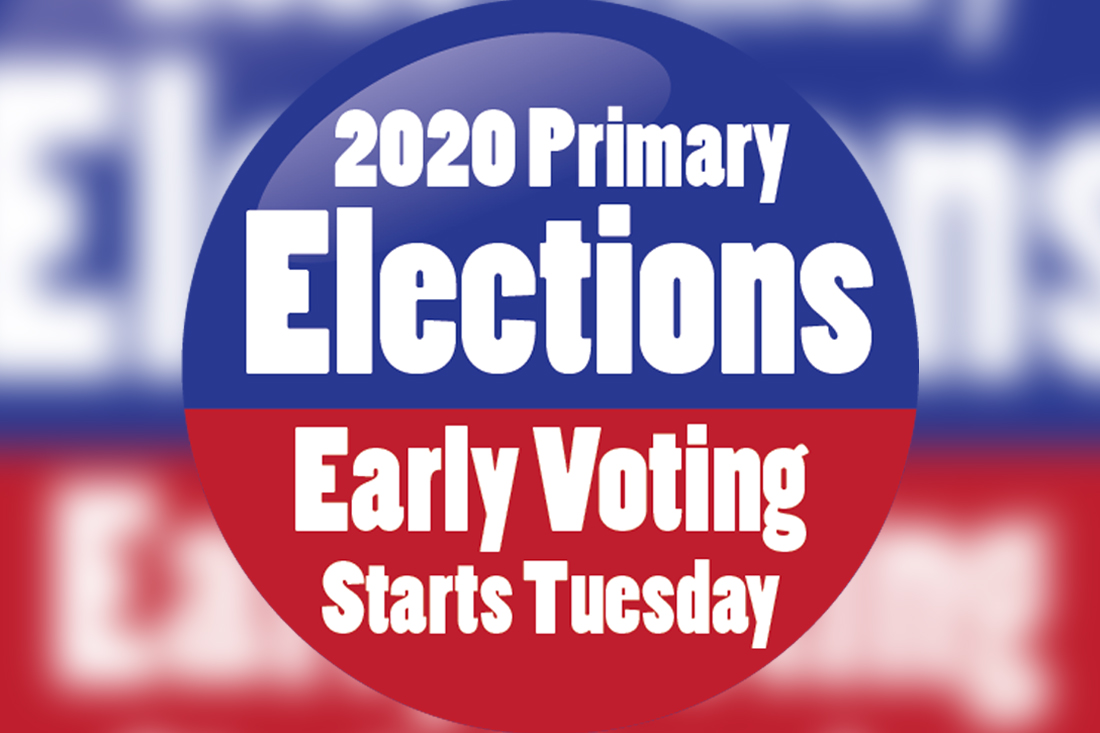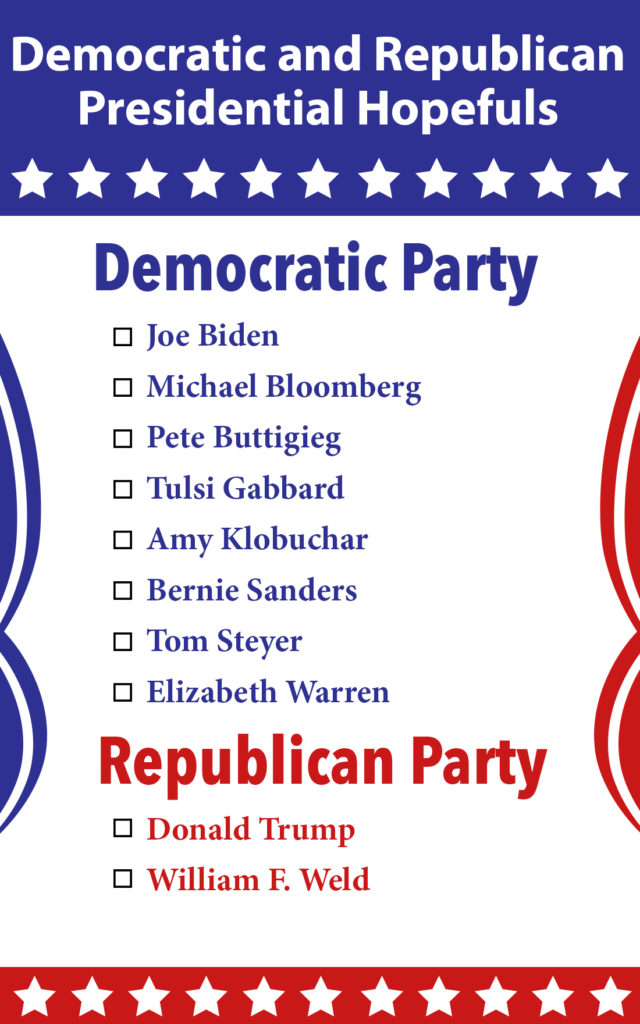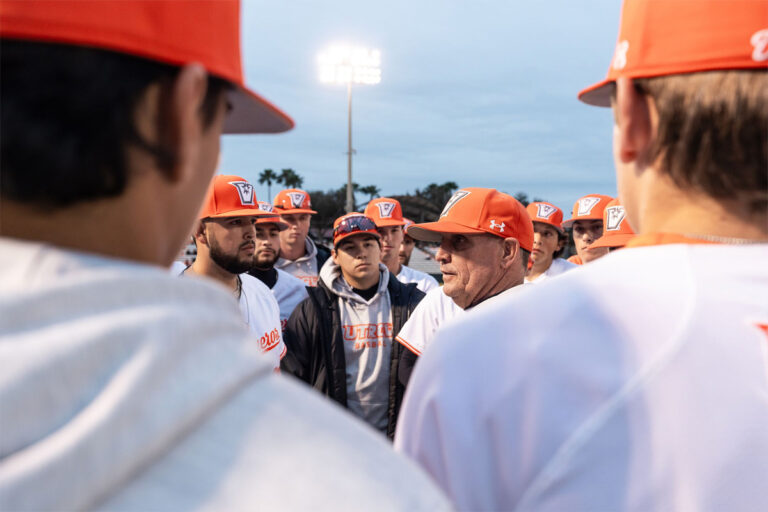
Beginning Tuesday, voters will be able to cast a ballot for the March 3 Primary Election to select a nominee for the November presidential race and state and local contests.
“There’s a reason why it’s called Super Tuesday,” said Andrew Smith, a UTRGV Political Science lecturer. “It’s because you’re having, not just Texas, but … a lot of states will be holding their primaries the same day. And, so, from the presidential standpoint, this is an opportunity for the presidential candidates to know better where they stand as far as delegates to the national conventions.”
With early voting taking place from Tuesday to Feb. 28, there are a few things Rio Grande Valley voters need to know before casting a ballot.
Who and what are on the ballot?
The results of the March 3 primary will determine the Democratic and Republican presidential nominees, U.S. senators and representatives, as well as state and county officials.
Other items to vote on include several propositions, depending on the type of ballot.
Seventeen Democrats and seven Republicans are listed in the different ballots; however, the list includes candidates who are no longer running for office, such as Republicans Bob Ely and Joe Walsh and Democrats Julian Castro and Michael Bennet.
Voters casting a ballot for the presidential nominee in the Republican Party Primary Election will choose between incumbent Donald Trump and former Massachusetts Gov. William F. Weld.
On the Democratic Party Primary Election ballot, presidential nominee hopefuls are former Vice President Joe Biden, former New York City Mayor Michael Bloomberg, former South Bend, Indiana, Mayor Pete Buttigieg, U.S. Rep. Tulsi Gabbard of Hawaii, Minnesota Sen. Amy Klobuchar, Vermont Sen. Bernie Sanders, former hedge fund executive Tom Steyer and Massachusetts Sen. Elizabeth Warren.
Other races in the March 3 election:
Cameron County
As reported by The Rider on Jan. 20, the most highly contested positions include:
–District 37 State Representative
–District 38 State Representative
–District 27 State Senator
–Cameron County Sheriff
–Justice of the Peace Precinct 2, Place 1
–Justice of the Peace Precinct 5, Place 1
–Justice of the Peace Precinct 5, Place 3
–138th State District Court Judge
–404th State District Court Judge
–County Commissioner Precinct 1
–County Constable Precinct 2
–County Constable Precinct 3
–County Constable Precinct 5
–and District Clerk
Hidalgo County
As reported by The Rider on Jan. 20, the following are among the positions on the ballot:
–District 28 U.S. Representative
–Place 7 Supreme Court Justice
–District 36 State Representative
–District 41 State Representative
–Justice for the 13th Court of Appeals District, Place 6
–464th State District Court Judge
–Hidalgo County Sheriff
–County Court at Law No. 9
–County Commissioner Precinct 1
–County Commissioner Precinct 3
–Justice of the Peace Precinct 1, Place 1
–Justice of the Peace Precinct 3, Place 1
–Justice of the Peace Precinct 4, Place 1
–County Constable Precinct 3
–and County Constable Precinct 4

Why should I vote?
Voting is a way to contribute and feel in control of the policies being made, Smith said.
“That starts by participating in elections and that participation starts with the primaries,” he said. “Second, I think if people are really concerned one way or the other with the ongoing crisis at the border, this is your opportunity to choose a candidate that is going to address that problem, perhaps more forcefully then the people already in charge.”
Remi Garza, Cameron County elections administrator, said it is important for young people and college students to vote during the primary season because it helps select who will be on the November ballot.
“I think it’s important because the younger you start voting, the more you’ll be likely to participate in the process,” Garza said. “So, the younger you start the better. … But I think ultimately, it’s the full expression of our citizenship and participating in our democracy. … The best way to protect your vote is to use it.”
About 20,000 Democrat and 7,000 Republican voters are expected to vote during early voting in Cameron County, according to Garza.
“We anticipate there’s going to be a pretty active year,” he said. “Primary turnout for both parties has been steadily increasing for [these] types of elections.”
The Rider tried to contact the Hidalgo County Elections Administrator Yvonne Ramón for an interview but was unsuccessful as of press time Thursday.
Smith advises younger voters to get informed through campaign websites, to look at major newspapers and attend rallies.
“If you find a candidate you like, get active,” he said. “It’s not too late to start handing out flyers, making phone calls, you know, it’s not too late to do that. And most important … once early voting starts, start voting.”
Can I vote?
Anyone who is a registered voter in Hidalgo and Cameron counties may cast their ballot during early voting.
To check voter registration status, visit votertexas.gov.
What do I need to bring?
State law requires a photo ID and there are seven acceptable forms, according to Garza:
–Texas Driver License
–Texas Election Identification
–Texas Personal Identification Card
–Texas Handgun License
–U.S. Military Identification Card
–U.S. Citizenship Certification
— and U.S. Passport
Garza said if an alternative document is needed, voters may claim a reasonable impediment.
“[These might] include things like your birth certificate, your Social Security card, your voter registration certificate or even your school ID, if it has a photo and an address on it, and issued through a university in the Texas system,” he said. “Also, if they need to, if they have their voter certificate, that’ll be helpful to make sure that we find them, but it’s not absolutely necessary in order to participate.”
Where do I vote?
Voters will be able to cast their ballot in 17 polling locations in Cameron County and 28 in Hidalgo County.
During early voting, voters may cast ballots at any early voting site in their respective counties. However, in the March 3 election, voters must cast a ballot in their precinct.
The UTRGV Edinburg campus will be a polling site during early voting and will be open from 7 a.m. to 7 p.m. Tuesday through Feb. 22, 10 a.m. to 3 p.m. Feb. 23 and 7 a.m. to 7 p.m. Feb. 24 through 28.
The UTRGV Brownsville campus will not be a voting site, but the Texas Southmost College Mary Rose Cardenas South Hall will serve as a polling site. The early voting site will be open from 9 a.m. to 7 p.m. Tuesday through Feb. 21, 8 a.m. to 8 p.m. Feb. 22, 9 a.m. to 2 p.m. Feb. 23, 9 a.m. to 7 p.m. Feb. 24 through 26 and 8 a.m. to 8 p.m. Feb. 27 and 28.
Asked why the UTRGV campus in Brownsville is not an early voting site, Garza replied via email, “The Election Commission and Commissioner[s’] Court selected the TSC Campus for the Primary. [House Bill] 1888 that went into law in September 2019, changed how early vote sites are managed, such as duration and the hours they have to be opened. They may alternate campus locations, but that will be decided on an election by election basis.”
To view all polling locations, visit the election websites for Cameron (https://tinyurl.com/s9fyj6w) and Hidalgo (https://tinyurl.com/w7ql6vj) counties. For more information, call 544-0809 in Cameron County and 318-2570 in Hidalgo County.






